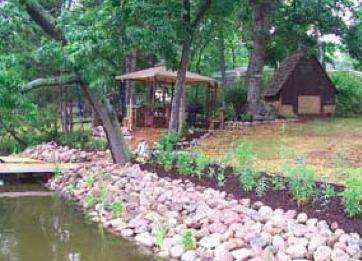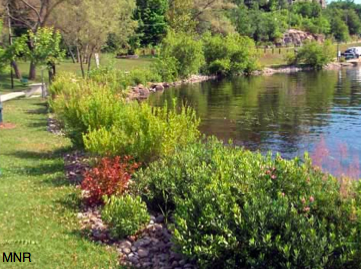BUREAUCRATS GONE WILD?
Wentworth says that we have to leave a 10 meter buffer zone around all our lakes. For the old folk, this means that we can’t touch anything growing within 33 feet of the lake (apart from a path to get to the lake). We are under strict orders to let this all grow wild. If we cut a branch, trim a bush, or mow a lawn, we can get a ticket of $450, and be threatened with a fine of $300 per day until we replant. If you don’t believe me, call our bureaucrats at 450-562-0701
What this means, practically speaking, is that we lose the use of most of our waterfront, and waterfront is precisely the reason we got our lakefront properties in the first place. A typical lot can be 100 feet wide X 100 feet deep. If we can’t use the first 33 feet, that means we’re losing the use of 1/3 of our property.
This seems very severe. It would be logical to think there’s a big danger involved. Surely it’s not just bureaucrats gone wild.
To figure this out I’ve become Wentworth’s biggest expert on buffer zones, studying research from all around the world.
The first inescapable conclusion is that all the research in the world has to do with buffer zones where farmland is close to water. The biggest concern is pesticide getting into the water. Of course, in Wentworth there is no farmland, so the primary reason for buffer zones doesn’t exist at all. The next biggest purpose of buffer zones is to stop herbicides from getting into the water. Again, since we don’t farm, this problem doesn’t exist either. The third reason is to prevent fertilizer from getting into water. Again, it doesn’t apply to us.
Before going on, this bears repeating, there’s no research anywhere about the need for buffer zones when there’s nothing to buffer. We’re not surrounded by farms – we’re surrounded by forest. There’s nothing in Wentworth except for lakes and buffer zones. The fundamental purpose of buffer zones is to protect against agricultural surface run-off, but in Wentworth there’s no such runoff.
ABSURDITY ON STEROIDS
In any case, let’s pretend that all our forests are farms, and the land gets plowed, dried out, and compacted so hard that there’s lots of runoff carrying agricultural pollutants into the lake. If so, what exactly would the scientists advise us to plant in the buffer zones? Here is the latest research according to the Swedish University of Agricultural Science, A Review of the Knowledge Focusing on Vegetated Buffer Strips – 2012.
“The choice of plant/s can be important for vegetated buffer strip effectiveness and function … Grass is often more tolerant and … provides good resistance to erosive flows.”
In other words, the plant of choice validated by the most exhaustive and recent study is grass. Remember, this is for buffer zones alongside agricultural land. In other words, if there were anything to buffer, then grass would do a fine job.
Finally, to be very explicit about this, adding trees to the buffer zone doesn’t help according to a major study in March 2010 by a group of Quebec and Canadian scientists (Caron, LaFrance, Auclair et Duchemin) published at www.soils.org, which says that “NO significant difference in the capacity to reduce herbicide exports was observed between grass and grass+tree buffer strip treatments“.
In fact, although it sounds bizarre, trees themselves can cause problems, (Limnetica 2006, The ecology of the Iberian inland waters) because the pretty autumn leaves that fall into our lakes quickly decompose into phosphorus and nitrogen, which are the same runoff fertilizer chemicals that buffer zones are designed to capture. Decaying leaves are the primary non-human source of this “pollution”, so there’s an intriguing case to be made that the best way to preserve our current pristine status is NOT to have so many trees so close to our waterways (see article, Falling Autumn Leaves).
(Incidentally, Ontario allows lawns on waterfront property, but suggest not cutting shorter than 3 inches, so the grass doesn’t dry out. Below please see photo examples of what they call excellent examples of shoreline protection.)
Surely, you think, there must be some explanation. Things couldn’t possibly be so completely upside-down in Wentworth. After all, Wentworth is part of a group of municipalities called the MRC d’Argenteuil, and they’re all guided by the Quebec Government. Well, as you may have read above, after being pushed hard through access to information legislation, the Quebec Ministry of the Environment admitted: After verification, we have been informed that the government doesn’t have a single document providing scientific support for its policy on protection of waterways and flood plains.
“Apres verification, nous sommes informes que le Ministere ne detient aucun document portant sur la justification scientifique de la Politique de protection des rives, du littoral et des plaines inondables.”
In other words the Quebec Ministry of the Environment simply made up policies about buffer strips that have no relationship to science. In a back-handed way to avoid responsibility for its own hollow policy and legislation, the Official Preamble to Quebec’s Law on the Environment (468-2005 Protection Policies for Lakeshores, Riverbanks, Littoral Zones and Floodplains) (translated) says “In order to enable the adoption of measures best suited for a regional municipality [eg Wentworth] …the implementation can take local situations into account [since] strict enforcement of the policy does not always correspond to reality.”
In other words, what Quebec says is that they’re giving a gun to the municipality, and if they choose to use it, it’s up to them. Tempted by these powers, our local bureaucrats passed the most severe laws in the province, and are ordering us to let 10 meters of waterfront grow wild, and doling out tickets of $450 to people for mowing lawns and trimming bushes. All this in a municipality with the healthiest, cleanest and most stable lake water purity in the province.
To add a bit of common sense to this discussion, it’s worth knowing that buffer zones can theoretically do two things, (1) filter out pollutants, and (2) prevent erosion by retaining soil within the plant root structure.
(1) Since there’s no farming in Wentworth, as long as we’re not putting chemicals on our property, there’s nothing to filter. Anyone disobeying common sense would have a lawn greener than others, and would have no dandelions or chickweed. If they were told, they would surely stop without the need for legislative guns, such as $450 tickets and fines of $300 per day.
(2) In order to prevent erosion, any kind of vegetation will do as long as it doesn’t get washed out by waves or rain storms. This is highly dependent on the conditions at each property, and the biggest loser from erosion would be the property owner, since it’s their own shoreline that would slowly dissolve into the lake. Nobody wants that, and wherever necessary, shrubs and bushes could be planted where grass roots aren’t deep enough to resist erosion. Nothing more needs to be done than tell the property owner they’re slowly losing their own property.
The extreme Wentworth prohibitions against trimming lakefront hedges or tree branches are devoid of science and common sense. Remember that when elections come in a few weeks, and be sure you are registered to vote NOW!
(Any bureaucrats reading this, at any level of government, please note, there’s a comment section wide open for you to use. If you disagree with anything here, leave a reply. We’ll be happy to publish it. If you don’t leave a reply, we have the right to believe you can’t find anything wrong in this article.)
***
For what it’s worth here are pictures from the Ontario Ministry of Natural Resources (MNR) showing what they call “best practices” for the environment.
MNR: ONTARIO BEST PRACTICES:
Stay tuned and check back often. Lots of news coming here in the next few weeks.


Bonjour!
Merci pour cette recherche et ses résultats surprenants. Cela laisse songeur.
J’avais l’intention de voter contre l’équipe en place à la mairie de Wentworth. J’avais déjà quelques bonnes raisons, mais vous m’en fournissez d’autres.
Ici, à Wentworth, on dirait que le gros bon sens est mort.
Continuez votre beau travail. Merci encore,
Yves Martel